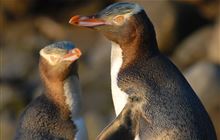Yellow-eyed penguin/hoiho annual breeding results
Archived content: This media release was accurate on the date of publication.
Introduction
Along with the Yellow-eyed Penguin Trust and others, we have completed the annual yellow-eyed penguins/hoiho monitoring along the Otago and Southland coastline. It's estimated that there are 260 breeding pairs.Date: 07 February 2017
This number is still of concern given historically there were between 400-600 breeding pairs and the current number is a repeat of last year - the lowest for 25 years.
During the monitoring, some consistent issues were identified such as avian diphtheria in chicks and some unexplained adult deaths.
The avian diphtheria in young chicks is treated through the removal of lesions and supplementary feeding if required. However, the unexplained adult deaths require further investigation.
DOC's Coastal Otago Operations Manager Annie Wallace says "a small number of dead adult yellow-eyed penguins have recently been found as part of regular penguin nest monitoring. This is not unusual for this time of year however we are mindful of the 2013 event where 67 adult penguins died, an event that only affected yellow-eyed penguin/hoiho adults. We are working with Wildbase of Massey University to determine the likely cause of these deaths. In the interim we are increasing the frequency of monitoring penguin sites".
Yellow-eyed Penguin Trust science advisor Trudi Webster says "Because of the 2013 event, we are being proactive in collecting samples from the dead penguins for testing. We plan to use analysis of these results to compare to the 2013 event".
In the meantime any penguin chicks who have lost their parents are taken to one of the rehabilitation centres along the Otago coastline for supplementary feeding and care until they fledge. Penguin chicks are due to fledge (go to sea) from mid-February so it is important that they are well fed and have a good body weight to ensure their survival.
The routine monitoring is an opportunity to also identify underweight adult birds which are then taken into rehabilitation for supplementary feeding before they enter their annual moult. This is a period where the penguins remain on land for approximately three weeks to shed their old feathers for a new set.
"Please call DOC's Hotline on 0800 DOC HOT (0800 362 468 if you come across yellow-eyed penguins along the Otago and Southland coastline and are concerned about their condition, describing as accurately as possible when and where the bird was found" says Annie Wallace.
Contact
Operational matters:
DOC Coastal Otago Operations Manager
Annie Wallace
Phone: +64 27 499 5180
Technical matters:
DOC Wildlife Vet & Wildlife Health Co-ordinator
Kate McInnes
Phone: +64 27 480 3365
Conservation or Science advice:
Yellow-eyed Penguin Trust General Manager
Sue Murray
Phone: +64 21 488 285
Scientist
Trudi Webster
Phone: +64 21 26444 32

